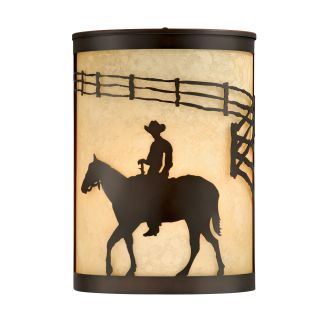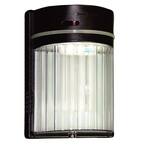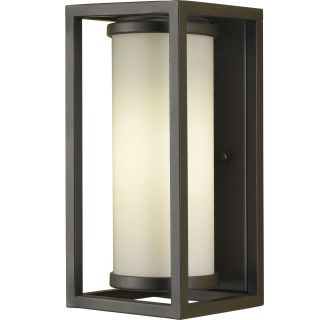 |
| Happy Trails Sconce I've ordered for Driveway Lamp |
My home has always had two front lights, a front door light and a driveway light attached to the front of the garage on the right hand side which leads to the front door. (The front door is 20 feet behind the front of the garage…a typical 1960's design which my small and inexpensive 1983-built home emulated--and I like because I like having my living spaces far from the street.)
 |
| Lights of America |
The 27 watt LOA units did exactly what they were supposed to. The security light is very bright, and has reliably come on every night (sometimes staying on during cloudy days). The light definitely has a blue-ish cast typical of fluorescent lighting, and that's fine for visibility and security, though it doesn't make your home seem nicer, just safer. Brand new, they look utilitarian at best, cheap at worst, and over time the clear plastic shield turns yellow and the inside tends to fill up with dead bugs.
Since the first install in 1992 I've replaced the front and back lamp units one time each after the internal ballast died. So they don't last forever, but during the typically 12 years or so these units lasted they were perfectly reliable, and that's about all you can ask from any photocell controlled light. The bulbs go for about 5 years, which is excellent for bulbs running an average of 12 hours a day. (Often you see "20 year" lifetimes calculated for running the lights 3 hours per day. Well that would be the same as 5 years running 12 hours per day.)
The primary fault with these lights is that they attract bugs like a magnet. I think fluorescents do that generally because of the high UV or near-UV content of the light. LED lights, at least running at very low powers like 12 watts or less, don't seem to attract many bugs, though the 3W Miracle LED "Bug Lite" is the best of all for not attracting bugs due to low power and lack of higher wavelengths.
Anyway, the one LOA lamp that hasn't yet been replaced is the one in front of the Garage Door. I haven't used it in so long I can't remember how long it's been. I quit using it around 1999 or so because then I was parking my car in the driveway, and I had to walk past this light (where bugs were swarming) to get to the front door. There are some months when we are inundated with bugs, so I think that must have been the last straw.
I pretty much forgot about the driveway light because the front door light is so bright that in my opinion there is plenty of light in the front yard, and now it is further augmented by a city streetlight at the corner which is just one house away. But the lack of a dedicated light for the driveway has been a concern for my friend, who has often seen strangers walking down the street when she goes to her car parked in the driveway. So, for some time, a new light has been called for, but I only got around to ordering one this week.
I spent many hours over many days looking at lights online. I found the Happy Trails Sconce in about the middle of my searching. It has the basics: a photocell (very rare in sconces generally), wet certification, takes a single E26 bulb up to 100W, covers the bulb up (so you don't see a bare bulb), diffuses the bare bulb light but doesn't reduce it much, and has some charm, I think (unlike the charmless but practical LOA units). I think I'll be lucky if it holds up as well as the LOA units.
I do not plan to use an incandescent lamp, but now that LED bulbs are infinitely available with edison bases, an E26 base is the best thing to have. That was the biggest problem I found with other lights. I was very much attracted to the more expensive looking (and more expensive!) lights from Murray Feiss, for example, the OLPL7000:

I love the "Modern" style, with apparently very solid construction. However this is set up to use a GU24 fluorescent light bulb, and has no photocell. Very many of the more expensive light fixtures I looked at were set up to use GU24 or similar fluorescents. Now that we have LED bulbs with Edison bases, these are anachronistic. Fluorescent bulbs contain mercury, have a less pleasant light, are not as reliable, and are incredibly attractive to bugs compared with LED lights.
I'm not sure about adding photocells to fixtures that don't have them. That *might* be possible, but sounds risky (to buy an expensive fixture without knowing whether it can be so adapted) and is at least going to take some work.
Beyond the fact that the Happy Trails light is less impressive looking than other outdoor sconces, what actually bothers me the most is the acrylic shield. This is an east facing garage door and the morning sunlight can be very intense. I have little doubt that the acrylic shield in the Happy Trails sconce will eventually get ugly and possibly even useless as a result of exposure to the sunlight.
An acrylic shield is a common feature of the less expensive sconces ($100 still being in that category). The more expensive sconces, including the Murray Feiss shown above, tend to use glass. With glass there need be little concern for long term stability, so I really wanted to find a better sconce with a glass shield. After many more hours of looking, however, I gave up, and decided to go with the Happy Trails. When the Acrylic wears out, perhaps I'll find a way to make a glass replacement, or just get another light.
Another issue with most sconces is the size. My garage front is unusual. The lamp is wedged between trim pieces on a very narrow side of the garage door. There is about 5 inches between the trim pieces, which stick out about 1 inch. The trim pieces themselves are about 4 inches wide. So there is plenty of overall width, but "hanging" sconces which have a back plate might not do well if the back plate is wider than 5 inches (as they almost all are). And even then they might not do well. It occurs to me that a hanging sconce (whether freely hanging or rigid) is going to apply more force on the base. If the base is wider than the gap between the trip pieces, it will need to rest on the trim pieces themselves. And because of extension, it will be applying a lot of force to the trip pieces, which is not good. Even entirely within the gap, this extra force might not be good.
The way the LOA lights "fit" is that they are wider than the gap, so they bridge across the gap, and an extra trim piece was added on top within the gap to keep water out from the center. That's what I'm planning to do with the Happy Trails light, which is a little bit smaller but still not narrow enough to fit within the gap.
I also didn't like lights that are freely hanging. That worries me.
Finally, given the compact space in the driveway and the walkway along the side of the garage, it's good to have a light with minimal extension. Happy Trails has a 5 inch extension. All of the hanging style sconces have a greater extension, up to a foot or so. ADA requirement is for 4 inches extension or less. Very very few sconces meet the ADA requirement.
I found several interesting places to look for built-in light fixtures. The most unique and interesting lights were at Hansenlighting.com, though the average price was high and many lamps cost more than $1000. They seemed to have not just hundreds but thousands of lamps, and at least some were affordable. In the end, however, I didn't find any lamps that worked for me. A major brand featured at Hanson is Meyda Tiffany and they have amazing lights…some that are remarkably inexpensive relative to the very high class looks and apparent construction. I'd be tempted to get a Tiffany tulip sconce for inside the house because they are so cool looking at yet quite inexpensive. The downside is that the electrical installation would likely be very expensive or maybe not possible.
Another interesting place is Bellacor.com. Second most interesting collection after Hansen. They had the Happy Trails, but not in stock, and it was not the first place I saw it.
Murray Feiss has their own website with an amazingly large collection of Murray Feiss lights. I was especially tempted by the Costa Del Luz, a very nice looking and apparently well made light on sale at a remarkably low price. But it looked like it would be a very difficult install for me (see above) because of the wide open part coupled to relatively narrow backplate (the specs don't seem to match the picture…it lists overall width as 8.5 inches with backplate width as 9.5 inches). Anyway, it also lacks photo sensor (but I'd be tempted to try adding one).
CarolinaRustica.com has an interesting collection of Meyda Tiffany featuring the animal figure lights.
Also of course Build.com (excellent selection and searching), ATGStores.com (owned by Lowes, but far bigger selection than any brick and mortar store), and lightingdirect.com.
I looked at the Craftmade brand since I liked their outdoor floodlight better than two others I ordered in 2011, but didn't see any suitable lamps for the garage door location. Here's one that seems just a bit too wide at 5 inches width and 6.5 inches "backplate/canopy" width. Since the backplate and canopy represent the entire piece, the two width specs should be the same. It might fit if the backplate width is actually the smaller number (though from the photo, it looks like the backplate might be wider than the canopy, which is quite unusual). However this has another rub that I've seen in many other lights. The extension part of the light doesn't extend at all from the backplate, there is only a tiny gap between the two. That means that both the backplate AND the extension (canopy, etc) have to fit in the gap. That clearly won't work for my location. If I'm going to have a lamp with a wider canopy than the backplate, the canopy will also have to extend out at least 1" from the wall side of the backplate. Here's a Craftmade light with a small backplate that would fit the gap OK, and it looks like the extension is large enough to clear the trim, but it takes two candelabra bulbs instead of one E26.
Here's a light at Signature Hardware that looks nice, and the backplate would fit in the center space. Takes E26 (medium Edison) bulb. But doesn't have photocell.

No comments:
Post a Comment